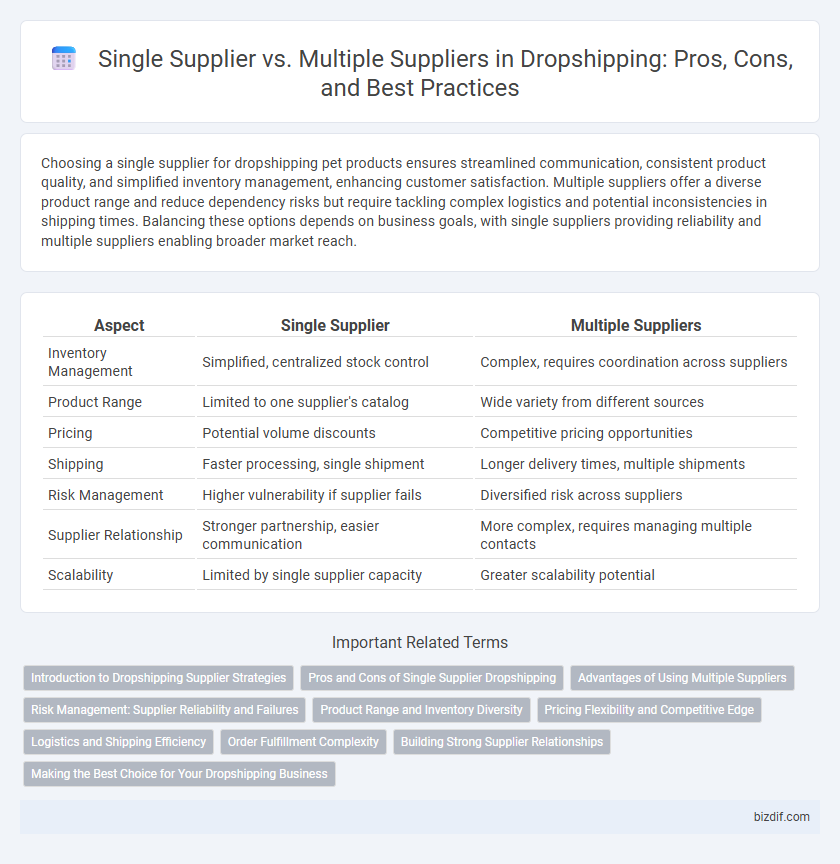Choosing a single supplier for dropshipping pet products ensures streamlined communication, consistent product quality, and simplified inventory management, enhancing customer satisfaction. Multiple suppliers offer a diverse product range and reduce dependency risks but require tackling complex logistics and potential inconsistencies in shipping times. Balancing these options depends on business goals, with single suppliers providing reliability and multiple suppliers enabling broader market reach.
Table of Comparison
| Aspect | Single Supplier | Multiple Suppliers |
|---|---|---|
| Inventory Management | Simplified, centralized stock control | Complex, requires coordination across suppliers |
| Product Range | Limited to one supplier's catalog | Wide variety from different sources |
| Pricing | Potential volume discounts | Competitive pricing opportunities |
| Shipping | Faster processing, single shipment | Longer delivery times, multiple shipments |
| Risk Management | Higher vulnerability if supplier fails | Diversified risk across suppliers |
| Supplier Relationship | Stronger partnership, easier communication | More complex, requires managing multiple contacts |
| Scalability | Limited by single supplier capacity | Greater scalability potential |
Introduction to Dropshipping Supplier Strategies
Dropshipping supplier strategies impact inventory management, order fulfillment speed, and risk mitigation. Single supplier models simplify communication and foster stronger partnerships but may face stock shortages or supply disruptions. Multiple suppliers diversify product sources, reducing dependency risks and expanding product ranges, though coordination complexity increases.
Pros and Cons of Single Supplier Dropshipping
Single supplier dropshipping simplifies inventory management and order fulfillment by centralizing product sourcing through one reliable vendor, reducing communication errors and streamlining logistics. However, reliance on a single supplier increases risk exposure to stock shortages, price changes, or supplier disruptions, which can negatively impact customer satisfaction and sales continuity. Consistent product quality and faster shipping times are advantages, but limited product variety and reduced negotiation leverage remain potential drawbacks.
Advantages of Using Multiple Suppliers
Using multiple suppliers in dropshipping minimizes the risk of stock shortages and enhances product variety, ensuring a more consistent customer experience. It allows entrepreneurs to leverage competitive pricing, better shipping options, and faster order fulfillment by selecting the best suppliers for each product category. Diversifying suppliers also mitigates reliance on a single source, protecting the business from disruptions caused by supplier issues or delays.
Risk Management: Supplier Reliability and Failures
Relying on a single supplier in dropshipping increases vulnerability to inventory shortages and shipment delays, which can disrupt customer satisfaction and sales continuity. Utilizing multiple suppliers diversifies risk, ensuring alternative sources are available if one supplier faces stock issues, quality problems, or operational failures. Effective supplier reliability assessment and regular performance monitoring are critical to minimizing risk and maintaining consistent order fulfillment.
Product Range and Inventory Diversity
Choosing a single supplier limits product range but ensures consistent quality and streamlined inventory management, ideal for specialized niches. Multiple suppliers expand product variety and inventory diversity, reducing stockouts and increasing customer options. Balancing supplier numbers optimizes inventory control while meeting diverse market demands in dropshipping.
Pricing Flexibility and Competitive Edge
Relying on a single supplier in dropshipping limits pricing flexibility due to fixed wholesale costs and minimal negotiation leverage, potentially reducing profit margins. Using multiple suppliers increases competitive edge by enabling price comparisons, bulk discounts, and dynamic pricing strategies that adapt to market demand. Diversifying suppliers also mitigates risks such as stock shortages and delivery delays, enhancing customer satisfaction and long-term business resilience.
Logistics and Shipping Efficiency
Relying on a single supplier streamlines logistics and shipping processes, reducing coordination complexity and minimizing shipment delays. Multiple suppliers may increase risks of inconsistent shipping times, higher shipping costs, and complicated inventory tracking across different regions. Optimizing dropshipping efficiency involves balancing supplier diversity with the ability to maintain reliable, fast delivery to customers.
Order Fulfillment Complexity
Order fulfillment complexity increases with multiple suppliers due to varied shipping times, packaging standards, and inventory management systems, leading to potential delays and higher error rates. Single supplier arrangements streamline order processing, reducing coordination efforts and simplifying tracking and returns. Efficient dropshipping operations rely on minimizing fulfillment risks by choosing suppliers with consistent reliability and integrated logistics support.
Building Strong Supplier Relationships
Building strong supplier relationships in dropshipping is crucial whether working with a single supplier or multiple suppliers. A single supplier allows for deeper communication, consistent product quality, and streamlined logistics, fostering trust and priority service. Managing multiple suppliers demands coordinated communication and quality control but diversifies product offerings and reduces dependency risks, enhancing overall business resilience.
Making the Best Choice for Your Dropshipping Business
Choosing between a single supplier and multiple suppliers impacts efficiency, risk management, and product variety in your dropshipping business. A single supplier simplifies order management and strengthens supplier relationships but increases dependency and potential supply chain disruptions. Multiple suppliers diversify product options and mitigate risks but require more complex coordination and quality control.
Single Supplier vs Multiple Suppliers Infographic

 bizdif.com
bizdif.com